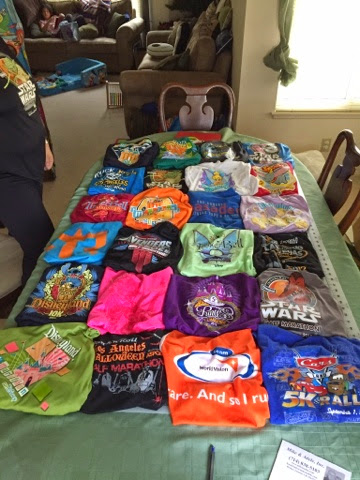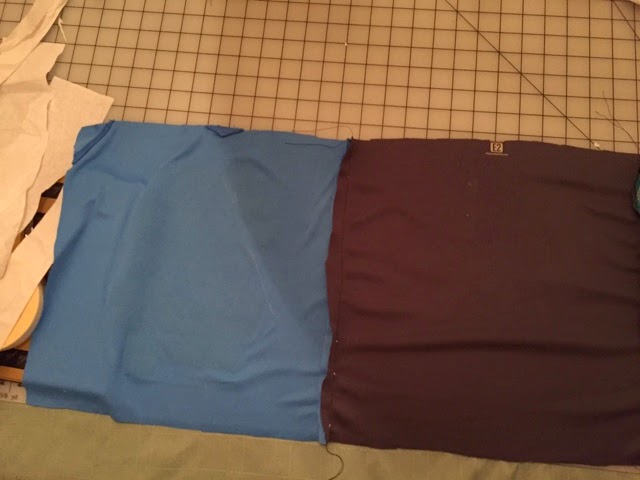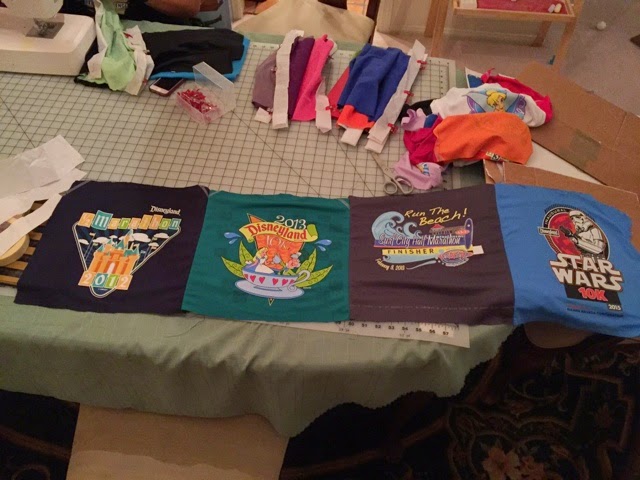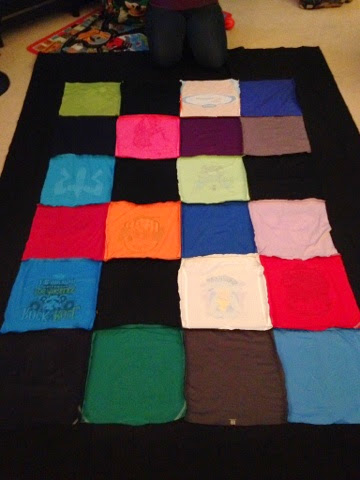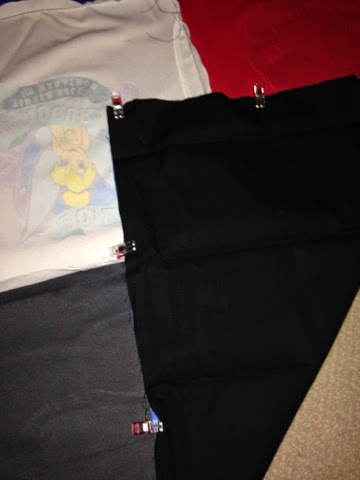It's amazing how many shirts you can accumulate from running races. It can be quite an addiction. But then these shirts just pile up in the closet, unworn, and unappreciated. What better way is there to enjoy them than to turn them into a blanket?
So, while our husbands watched the big game in the family room, and our kids played in the living room, my cousin-in-law (Sole Sister) Dawn and I set up shop in the dining room to make a quilt out of some of her race tech shirts. And the amazing thing is, we FINISHED the entire project in ONE EVENING...and using TECH shirts.
The most common comments that I've read on social media when people discuss sewing knitted fabric or even tech fabric are "It's too difficult to sew" or "You HAVE to use fusible interfacing." My response to those naysayers is "It's actually not that difficult. You just need the right technique." (See Step 4 below.)
What were the reasons we made the quilt ourselves?
1. Sewing is fun...for me at least.
2. It saves money. $200+ to send shirts to a company to turn them into a quilt? I could sign up for another half marathon with that money. [Update: After posting, I've seen that some websites charge up to $1200 for a king size quilt. Yikes!]
3. You can control the entire creative process, from start to finish.
4. The added satisfaction of knowing that, in addition to the achievements each shirt represents, the quilt itself represents an achievement of your own craftiness.
So what was the creative process?
STEP 1: Figure out what size quilt to make.
The typical T-shirt quilt panel size is 12"x12" after the quilt is finished. There is a good reason for this: it maximizes the amount of graphic that can be included in the panel, AND it's the maximum width of most tech shirts (we used size medium and large tech shirts for this quilt.
We decided to use a Twin-size flat sheet (68" x 98") as the backing of the quilt because it's light-weight (it doesn't really get that cold in SoCal), inexpensive, and easy/fast to find at most stores. But you can use any type of fabric (eg. Fleece from the fabric store, an old blanket, sheets from your closet, thrift store finds, etc.).
Based on your backing fabric's dimensions, just divide each dimension by 12". That means our flat sheet (68" x 98") would be able to fit 5 x 8 shirts = 40 shirts.
Dawn brought 24 shirts to my house. So we had a decision to make:
Make a quilt that's 4x6 panels and therefore smaller than the twin sheet.
vs.
Make a quilt that's 5x8 panels but only use 20 shirts and make 20 "filler panels".
We decided to make the 4x6 size because it would be faster to make and would incorporate all of her shirts.
STEP 2: Figure out quilt design.
We decided that the best arrangement would be a checkerboard design alternating between dark and light shirts so that each individual shirt could stand out. So we divided the shirts into two piles: dark & light. 7 shirts were obvious dark ones, so the challenge was deciding which medium ones we'd consider as "dark".
Once we had the two separate piles, we arranged the dark shirts first into the checkerboard, then followed by the light shirts. We tried to evenly distribute the color families so that one row/column didn't have two of each color. Can you say t-shirt Sudoku?
When we were satisfied with the arrangement, we snapped a photo to use as reference.
STEP 3: Cut the shirts.
Okay, so we've established that the finished panels are gonna be 12" x 12". If you factor in a 1/2 inch seam allowance, that means you need to cut out a 13" x 13" square from the shirt.
To make cutting out the panels easier, first make a cardboard template. Then place the shirt onto a cutting mat, position the cardboard template onto the shirt, then cut around them using a rotary cutter. But for the life of me, I couldn't find my rotary cutter; so instead I used my 3-year-old's chalk to trace around the template, and then handed the shirt to Dawn so she could cut it out with fabric scissors. Assembly line style baby!
This was the toughest part of the process because it was the most tedious, but mainly because making the first cut into the first shirt was the most difficult emotionally. I can only imagine what Dawn was thinking as she cut into her shirts, but it probably went something like this: "Am I really doing this? Am I really going to destroy my beloved race shirt? I'll never be able to wear it again. Oh here I go! Hmm that wasn't so bad. Hey these cut out panels look great. Well, this isn't so bad after all. I can't wait to see what they look like when they're finally sewn together!"
STEP 4: Sew the panels together (aka. The secret to sewing with knitted fabric and tech fabric)
What's the secret trick? How do you make the knitted tech fabric keep it's shape and prevent it from stretching when you're sewing it WITHOUT using fusible interfacing? ANSWER: Tissue paper. Ooooh, mind blown!
Place two panels front-sides together, then place the seam edge inside a folded strip of tissue paper making a sandwich. Pin the seam together, then sew the seam using a 1/2 inch seam allowance. I placed a strip of masking tape on my sewing machine at the 1/2 inch seam allowance mark to make it easier to see.
At first we used traditional pins, but found them to be time-consuming. So we used my box of Wonder Clips instead. OMG! So easy and so much faster, and they held the tissue paper sandwich more securely than traditional pins.
Once the seam has been sewn, just tear off the tissue paper. Don't worry about the little bits that might be left over, they'll wash off in the laundry.
Dawn pinned the shirt panels together, and I sewed. Hooray assembly line!
First I sewed the panels into rows of 4, using the reference photo from Step 2 as a guide. Once all 6 rows were completed, I sewed the rows together.
STEP 5: Attach quilt front to backing fabric.
(NOTE: If you want to add a cushiony layer of batting to your quilt, now's the time to do it. All you would need to do is sandwich the T-shirt layer between the batting and the backing fabric. Or instead of batting, you could use a fleece blanket. But since we live in SoCal, it doesn't really get that cold, so we wanted a lighter weight blanket and omitted any batting layer.)
This time instead of making a tissue paper sandwich, I just laid a strip of tissue paper on the tech fabric side of the quilt when I was sewing it. The twin sheet fabric was non-stretchy, so it didn't need the tissue paper on that side.
I sewed a seam around all 4 sides of the quilt, leaving a 12-inch opening at the top seam. Then we flipped the entire thing inside out (or should I say correct side out?) like a pillow case. Then, I sewed a top stitch (1/4" seam allowance) along the the outside border of the quilt to bind the border and to sew the 12-inch top seam opening shut.
(NOTE: This was the lazy way to bind the blanket...I know. But binding the blanket the traditional way would have taken longer. It was a school night. {Autotune} I ain't got time for that!)
STEP 6: "Quilt" the blanket (aka. Attaching the front layer to the back layer)
Sew along the seams between each shirt panel. This is called the "stitch in the ditch" technique. It's great because it's fast, it's easy, it uses straight lines, it doesn't require invisible thread, and it doesn't stitch over any of the shirt graphics.
STEP 7: Admire your handiwork and enjoy your quilt.
Yay!


